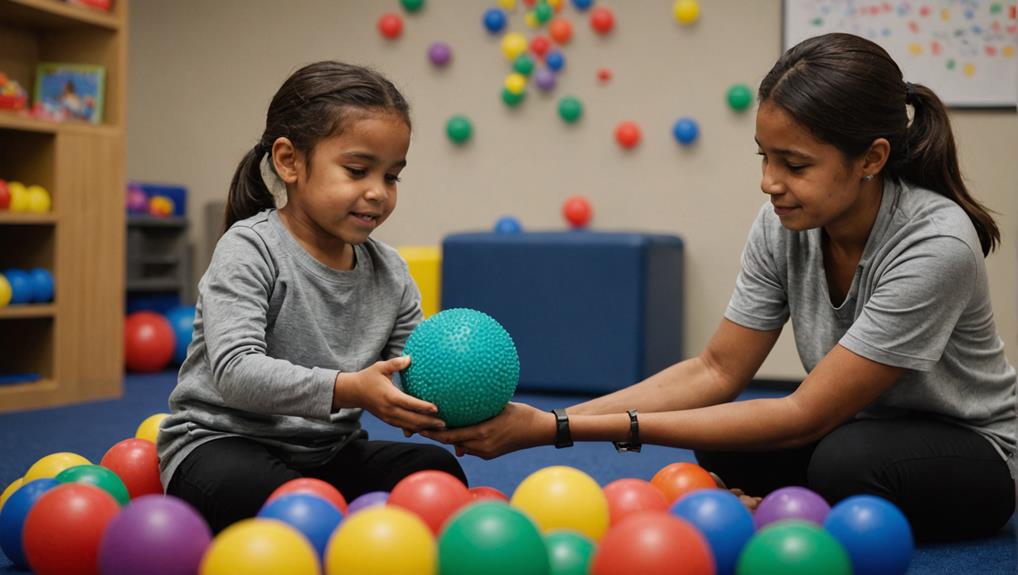Sensory Processing Disorder in kids can significantly affect a child’s development and daily life, making early detection essential. The signs of Sensory Processing Disorder in children are often subtle and may be misinterpreted as normal behavior, causing them to be overlooked. As a pediatric occupational therapist, I see many parents unsure of what to look for, especially when their child shows sensitivity to noise, touch, or movement.
In the Tampa area, it’s necessary to recognize the early signs to address any issues. This blog will highlight eight key signs of SPD that should not be ignored and explain how early intervention can make a lasting difference. By understanding these signs, parents can help their children navigate everyday challenges with the proper support.
Key Takeaways
- In children, extreme sensitivity to sensory stimuli, such as touch, sound, or movements, may indicate Sensory Processing Disorder (SPD).
- Children exhibiting delayed milestones, including motor skills, language development, and social interactions, may have SPD.
- Look for unusual behavioral patterns, such as heightened fussiness, difficulty with feeding, focusing, and attention span challenges.
- SPD may manifest as difficulties with coordination and daily activities like handwriting or excessive reactions to sensory inputs.
- Signs of SPD can also include difficulty understanding social cues, forming relationships, and participating in play activities.
Understanding Sensory Processing Disorder
Sensory Processing Disorder (SPD) is a pervasive condition that impacts how the nervous system interprets and utilizes sensory information. It can significantly affect children’s daily routines and play activities. Children with sensory processing difficulties may exhibit hypersensitivity, seeking more sensory input, or challenges with coordination and balance.
One effective strategy for managing these sensory challenges involves using Pediatric OT techniques, which improve focus and attention span in children through sensory integration and structured task management. Tailored interventions such as these can help prevent sensory overload and boost activity engagement boosting activity engagement.
These symptoms, or signs of SPD, can manifest in various ways and differ from child to child. Some children may overreact to sensory stimuli, while others may overreact or seek more sensory experiences. Additionally, children may have trouble with specific types of sensory input, such as touch, movement, or sound.
Occupational therapy, specifically sensory integration therapy, is often recommended to assist children with sensory processing challenges. This therapeutic approach aims to help children better process sensory information, allowing them to interact more effectively with their environment. The importance of early intervention in managing and improving sensory challenges for children with SPD cannot be overstated. Parents, caregivers, and professionals must understand this disorder to provide these children with the most supportive environment possible.
Recognizing Signs in Infancy
Recognizing Sensory Processing Disorder (SPD) in its infancy stage can be pivotal for early intervention. Key indicators can range from atypical sensory reactions, such as extreme sensitivity to touch or certain textures, to challenges in early motor skills, like delayed crawling or sitting up. Some children may also display signs reminiscent of early ADHD symptoms, such as excessive fidgeting or difficulty maintaining focus. Moreover, specific behavioral patterns, such as avoiding eye contact or being easily startled by sounds, may also signal the presence of SPD in infants.
Unusual Sensory Reactions
While all infants may seem sensitive to their surroundings, extreme reactions to stimuli like touch or sound could indicate Sensory Processing Disorder (SPD). An infant with this condition might exhibit uncommon sensory responses, which can suggest that parents seek professional advice.
These children may dislike certain textures, sounds, or movements that are generally well-tolerated by their peers. For example, you might observe your child crying excessively during diaper changes, resisting specific clothing textures, or having feeding difficulties. This behavior might reflect their distinct sensory needs, which can enhance the management of their sensory challenges when addressed appropriately. Pediatric occupational therapy, utilizing customized strategies such as sensory diets, can play a crucial role in addressing these sensory concerns customized strategies.
These signs are not typical infant behaviors and can indicate a sensory processing disorder. These uncommon sensory reactions can significantly affect a child’s ability to sell child’s and regulate emotions, which are crucial skills in their developmental path. Recognizing these signs early allows for timely intervention, offering the child the necessary support to navigate their sensory challenges.
Early Motor Skill Challenges
Most infants with Sensory Processing Disorder (SPD) may display difficulties with early motor skills. These issues, often noticeable when babies strive to achieve developmental milestones, can indicate underlying SPD. Some observable signs are difficulty crawling, sitting up, or reaching for objects on time.
Infants with sensory processing issues may show delays in:
- Rolling over
- Grasping objects
- Standing with support
These symptoms could be signs of challenges in sensory integration, a key component in motor skills development. As per pediatric occupational therapy insights, these sensory challenges can prevent infants from effectively processing stimuli, which is vital for learning and skill acquisition. These delays can reveal sensory stimulation and integration struggles, which are critical for motor skills development. Sensory issues in infancy can impact motor skill development, affecting the baby’s ability to observe their environment and interact with objects.
Parents must monitor their child’s motor skills and behavior. Persistent delays or challenges should not be disregarded, as they may indicate sensory processing issues. If you notice such signs, consult with healthcare professionals promptly. Early detection and intervention can significantly enhance outcomes, offering your child a better quality of life. Understanding and addressing SPD’s early motor skills challenges is fundamental to ensuring your child’s healthy development behavioral patterns.
Behavioral patterns in the early stages of a child’s life can provide clinical insights into possible sensory processing issues. Infants with Sensory Processing Disorder (SPD) often exhibit distinct signs that can be picked up by discerning parents or caregivers. Extreme fussiness, difficulty with feeding, or an aversion to being touched are common indicators of SPD in infants.
Moreover, sensory issues can manifest as heightened sensitivity in infants. This sensitivity can be towards noise, light, or textures, and it can cause significant discomfort for the infant. Establishing a consistent and nurturing routine and a structured morning routine at this stage can help manage these symptoms.
Another sign of SPD is the infant’s inability to develop, which is often coupled with delayed motor development and resistance to being held. Excessive crying, difficulty with sleep, or an aversion to specific movements can also signal SPD in infants. Recognizing these signs early can lead to effective interventions and support, significantly improving the quality of life for the child and their family. Understanding these behavioral patterns is crucial for parents and caregivers in identifying and addressing sensory processing disorders in infancy.
Behavioral Challenges and Responses

Children diagnosed with sensory processing disorders often exhibit challenging behaviors that can be distressing for the child and their caregivers. These behavioral challenges can range from extreme behaviors, such as screaming when their face gets wet, to intense and prolonged temper tantrums triggered by environmental changes.
Understanding the cause of these behaviors is essential in managing them effectively. Sensory overload is often the root cause of children fleeing or becoming aggressive in specific environments. This reaction is how they usually cope with the overwhelming sensory input they cannot process.
Parents and caregivers can watch for these behaviors:
- Extreme reactions to minor changes in environment or routine
- Intense tantrums that last longer than typical for their age
- Aggressive or fleeing responses to specific sensory inputs
Understanding and responding compassionately to these behaviors can significantly improve the child’s experience and distress for the entire family. It is vital to remember that these children are not misbehaving intentionally but responding to sensory overload in the only way they know how.
Impact on Developmental Delays
Sensory Processing Disorder (SPD) can significantly impact a child’s development, especially in fine and gross motor skills, coordination, and social interactions. This disorder may lead to struggles performing daily activities like handwriting or tying shoelaces due to impaired motor skills. Furthermore, it is crucial to discuss the role of therapeutic interventions in mitigating these developmental delays and enhancing the child’s ability to engage in everyday tasks.
Identifying Delayed Milestones
Developmental milestones are significant markers in assessing the growth and progress of young children. Delays in milestones can have a noteworthy impact on the comprehensive development of children with sensory processing disorders. This delay may be visible in motor skills, language development, and social interactions.
Identifying these delayed milestones early is vital as it can significantly enhance the outcomes for these children. This early recognition paves the way for early intervention, a key strategy in managing sensory processing disorder. These interventions may include therapy and support services aimed at helping children overcome their developmental delays.
Monitoring and tracking developmental milestones are crucial in providing valuable insights into a child’s progress and support. They allow for a tailored intervention plan that addresses the child’s needs.
Three children to remember include:
- Delayed milestones in children with sensory processing disorder are not a sign of failure but an opportunity for targeted support.
- Early intervention is essential in helping children overcome their developmental delays.
- Regular monitoring of developmental milestones aids in timely intervention and support.
SPD’s Influence on Social Skills
Understanding how Sensory Processing Disorder (SPD) can profoundly impact a child’s ability to develop social skills is essential, resulting in significant delays in their general growth. SPD often hinders a child’s capacity to intervene effectively in social settings. This is because sensory challenges can make it extremely difficult for them to understand and respond to social cues appropriately, a key component of communication.
Children with SPD may find it hard to form relationships, engage in play, and navigate social situations. Their inability to process sensory information correctly often leads to difficulties interpreting others’ intentions and others ‘. This creates a barrier to communication, further impeding their social skills development.
Addressing these sensory processing issues is vital. While the specifics of intervention methods will be discussed in a later section, therapy can play a crucial role in improving these skills and enhancing the overall development of children with SPD. By providing the proper support, we can help these children overcome their sensory challenges, enabling them to interact more effectively and confidently in their social environment.
Therapy for Developmental Delays
Building on our understanding of SPD and its impact on social skills, we can focus on developmental delay therapy. These delays can manifest in various areas, such as motor skills, speech, cognitive abilities, and social-emotional development. Early intervention through treatment can significantly impact a child’s progress in these challenges.
Therapists utilize specific techniques and activities to target particular areas of delay. They aim to help children reach their developmental milestones. Occupational therapy plays an important role, especially for children with sensory processing disorders.
- Occupational therapy focuses on enhancing sensory integration, aiding children in processing and responding to sensory information effectively.
- It also supports the development of motor skills, essential for daily activities like dressing, eating, and writing.
- Consistent, structured therapy sessions under the guidance of an occupational therapist can make a significant difference in a child’s life.
Therapy developmental delays are tailored to each child’s needs and theding light. It’s a hope for many families, offering children the opportunity to reach their full potential and improve their quality of life.
Common Symptoms and Reactions
Within Sensory Processing Disorder (SPD), children often overreact to seemingly ordinary sensory stimuli. This response can manifest in two primary forms: sensory seeking, where the child with SPD craves or actively pursues intense sensory experiences, or sensory avoiding, where the child steers clear of certain types of sensory input altogether.
The indications of sensory processing issues can vary significantly but commonly include difficulty with transitions and a tendency to become easily overwhelmed by sensory input. This can impact the child’s ability to participate in daily activities, as the world around them may feel uncertain or even intimidating. Their reactions to sensory stimuli, which may seem excessive or inappropriate to others, are their way of navigating and making sense of their surroundings.
Parents and caregivers need to recognize these signs and understand that a child with SPD is not simply being challenging or resistant. Instead, they are grappling with a legitimate and often misunderstood condition. Recognizing these signs of sensory processing disorder is the initial step towards obtaining professional help and providing the necessary support to help the child thrive.
Misinterpreted Behavior in Kids
Children with Sensory Processing Disorder (SPD) often exhibit behaviors that are misinterpreted due to their unique sensory experiences. Extreme reactions to stimuli such as loud noises or uncomfortable textures may be perceived as overreactions or tantrums. Yet, these reactions often result from SPD, not intentional disobedience or lack of self-control.
Understanding sensory processing difficulties can help avoid misinterpreting behaviors. Key points to remember include:
- Children with SPD may exhibit mood swings due to difficulties processing sensory information. These mood swings are often a response to overwhelming sensory input, not a sign of mental instability.
- Changes in the environment can trigger intense tantrums in children with SPD. These tantrums are often responses to sensory overload, not intentional efforts to disrupt or seek attention.
- Sensory overload can result in children fleeing from or becoming aggressive in certain situations. This misunderstood behavior is often a protective response to overwhelming stimuli, not a sign of rebellion or animosity.
Serving children with SPD requires understanding and empathy. Recognizing the root cause of their reactions can help parents and caregivers provide the supportive environment these children need to thrive.
Pediatric Occupational Therapy Role

Pediatric occupational therapy is pivotal in supporting children with a sensory processing disorder. It focuses on helping these children develop skills needed for everyday tasks and activities. An occupational therapist assesses the sensory processing difficulties, identifies the signs Tampa parents may overlook, and crafts a personalized treatment plan for each child.
Therapy sessions often involve sensory-rich activities to boost the child’s ability to respond to sensory input effectively. These may include handling textured materials, listening to specific sounds, or practicing balance exercises. Coping strategies and interventions are also part of the therapy approach to improving sensory processing.
Pediatric occupational therapy’s ultimate therapy symptoms enhance the child’s quality of life and functioning. By diligently working with a child with sensory processing issues, the occupational therapist can significantly improve the child’s ability to engage in meaningful activities and interactions. Hence, pediatric occupational therapy is vital for children with sensory processing disorders, helping them navigate their world more easily.
Early Intervention and Treatment Options
Given the importance of early intervention for Sensory Processing Disorder (SPD), multiple treatment options have been developed to improve a child’s ability to process sensory information effectively. Implementing these strategies when SPD symptoms are recognized can significantly enhance a child’s quality of life and help them develop necessary coping mechanisms.
One of the most effective treatment methods is occupational therapy, which utilizes various activities to help children manage their SPD. This approach can enhance their ability to perform tasks that they find challenging due to their sensory difficulties.
Another essential treatment option is sensory integration therapy. It aims to assist children in better regulating their responses to sensory input, thereby reducing their discomfort and enhancing their overall functioning.
Creating a sensory-friendly environment can also greatly benefit children with SPD. This involves adapting a child’s surroundings to fit the child’s size and sensory triggers and optimize comfort.
To summarize, the three critical components of early intervention and treatment options for SPD are:
- Occupational therapy
- Sensory integration therapy
- Creating a sensory-friendly environment
These treatments are tailored to each child’s needs and can improve their ability to process sensory information effectively.
Frequently Asked Questions
What is Sensory Processing Disorder in Children?
Sensory Processing Disorder in kids occurs when the brain has trouble receiving and responding to sensory information. This can lead to challenges with everyday activities, but early intervention and occupational therapy can help improve a child’s sensory integration and skills.
How Do You Discipline a Child With Sensory Issues?
Disciplining a child with sensory issues requires understanding their triggers, using positive reinforcement, and creating sensory-friendly environments. Consistency in routines, clear expectations, and utilizing sensory tools can aid in behavior regulation. Collaboration with professionals is recommended.
What Are Red Flags for Sensory Processing Disorder?
Red flags for Sensory Processing Disorder encompass overreacting to sensations, discomfort with certain textures, avoidance of physical contact, balance issues, and difficulty with fine motor skills and changes. Early intervention is vital for improved adaptation.
What to Do if You Think Your Child Has Sensory Processing Disorder?
If you suspect your child has Sensory Processing Disorder, consult a pediatric occupational therapist for a thorough evaluation. Implementing sensory-friendly environments and sensory integration therapy is beneficial. Early intervention is critical to managing these sensory challenges.
What Calms Sensory Overload?
Calming sensory overload involves creating a quiet, structured environment, using deep pressure techniques, rhythmic activities, and sensory tools, and creating a sensory-friendly space with dim lighting, soft textures, and calming colors.
Conclusion
In conclusion, it is crucial to recognize the early signs of Sensory Processing Disorder in children. Early intervention can profoundly impact a child’s developmental journey, improving their ability to handle daily activities and enhancing their overall well-being.
Parents who stay vigilant and aware of potential signs of Sensory Processing Disorder in kids can make a significant difference in their child’s future. The sooner these signs are addressed, the greater the chance of helping children thrive and overcome the challenges of SPD.


Recent Comments